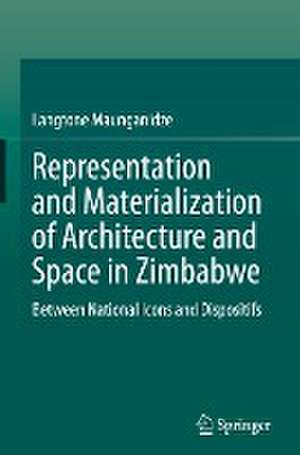Representation and Materialization of Architecture and Space in Zimbabwe: Between National Icons and Dispositifs
Autor Langtone Maunganidzeen Limba Engleză Hardback – 5 feb 2024
Preț: 781.15 lei
Preț vechi: 952.61 lei
-18% Nou
Puncte Express: 1172
Preț estimativ în valută:
149.48€ • 156.78$ • 124.43£
149.48€ • 156.78$ • 124.43£
Carte tipărită la comandă
Livrare economică 01-15 aprilie
Preluare comenzi: 021 569.72.76
Specificații
ISBN-13: 9783031477607
ISBN-10: 303147760X
Ilustrații: XVII, 153 p. 31 illus. in color.
Dimensiuni: 155 x 235 mm
Greutate: 0.42 kg
Ediția:1st ed. 2024
Editura: Springer Nature Switzerland
Colecția Springer
Locul publicării:Cham, Switzerland
ISBN-10: 303147760X
Ilustrații: XVII, 153 p. 31 illus. in color.
Dimensiuni: 155 x 235 mm
Greutate: 0.42 kg
Ediția:1st ed. 2024
Editura: Springer Nature Switzerland
Colecția Springer
Locul publicării:Cham, Switzerland
Cuprins
Chapter 1: Introduction.- Chapter 2: Framing iconic architecture: Context and dimensions.- Chapter 3: Materialization, space and identity.- Chapter 4: Inside Indigeneity and Iconicity: The African traditional hut.- Chapter 5: The sociology of museums and monuments.- Chapter 6: State buildings: Patterns and processes of materialization.- Chapter 7: The Zimbabwe Bird: The sovereign architecture.- Chapter 8: Religious architecture in Zimbabwe: a critical anthropological treatise.- Chapter 9: Urban informality and spatial re-figuration.- Chapter 10: Gender, architecture and space.- Chapter 11: Summary and conclusion.
Notă biografică
Langtone Maunganidze holds a PhD in Sociology obtained from the University of Zimbabwe. He is an Advanced Researcher and Senior Faculty member at the Midlands State University in Zimbabwe and a visiting scholar at the Global Center of Spatial Methods for Urban Sustainability (GCSMUS), at Technische Universitat (TU) in Berlin, Germany. Dr. Maunganidze’s experience in advanced degree supervision and thesis examination has taken him to numerous universities in Africa. His teaching and research interest areas include Architectural Sociology, Corporate Citizenship, Society and Digital Media, Industrial Sociology and Spatial Methods, and has published numerous academic pieces mainly book chapters and journal pieces within the scope of the stated interest areas. He has also co-edited a widely read text: “Corporate citizenship: Business and society in Botswana. Palgrave, Macmillan”.
Textul de pe ultima copertă
This volume is an empirical study examining the extent to which historic and iconic architecture and spaces in Zimbabwe - particularly in urban areas - have been mobilized to construct and reconstruct identities. The author explores the question of traditional and political architecture through analysis of a variety of structures, including monuments, museums, and indigenous and state buildings. Special attention is paid to the soapstone-carved Zimbabwe Bird, which for years has served as the national emblem. Overall, this book argues that while the production and use of architectural products and spaces have been regarded symbols of collective identity, they have also served as expressions of power and control.
Caracteristici
Explores patterns and processes of materialising iconic architecture and spaces in Zimbabwe
Analyzes the extent to which indigenous and traditional architectural designs have been embedded into the modern forms
Examines how colonial appropriation of architecture and spaces influenced post-colonial patterns and processes
Analyzes the extent to which indigenous and traditional architectural designs have been embedded into the modern forms
Examines how colonial appropriation of architecture and spaces influenced post-colonial patterns and processes
